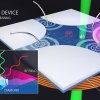Complex molecules such as DNA and small lifeforms such as viruses have distinct magnetic signatures that may be used in applications such as genetic analysis and disease diagnosis. A device developed by researchers from the Joint Quantum Institute (University of Maryland and the National Institute of Standards and Technology) have created a microfluidic sensor able to create a map of the magnetic field around a tiny particle. While detecting magnetic fields is nothing new, the new sensor is interesting because it relies on a diamond suspended within a fluid, allowing it to be used to detect biological particles in their own liquid environment.
The diamond itself is made to be slightly imperfect, which gives it special magnetic properties. When placed near a particle and bathed in RF radiation and green laser light, the diamond fluoresces with red light, the characteristics of which represent the strength of the magnetic field of the particle nearby. Moving the particle around the diamond provides a 3D view of the field. The researchers plan on using multiple diamond sensors in the next iterations of the device, which should allow a much more detailed picture of the magnetic fields of small particles.
Nitrogen vacancy (NV) color centers in diamond enable local magnetic field sensing with high sensitivity by optical detection of electron spin resonance (ESR). The integration of this capability with microfluidic technology has a broad range of applications in chemical and biological sensing. We demonstrate a method to perform localized magnetometry in a microfluidic device with a 48 nm spatial precision. The device manipulates individual magnetic particles in three dimensions using a combination of flow control and magnetic actuation. We map out the local field distribution of the magnetic particle by manipulating it in the vicinity of a single NV center and optically detecting the induced Zeeman shift with a magnetic field sensitivity of 17.5 µT Hz–1/2. Our results enable accurate nanoscale mapping of the magnetic field distribution of a broad range of target objects in a microfluidic device.
Source:Pubs.acs.org
Detecting Tiny Magnetic Fields, with Diamonds

